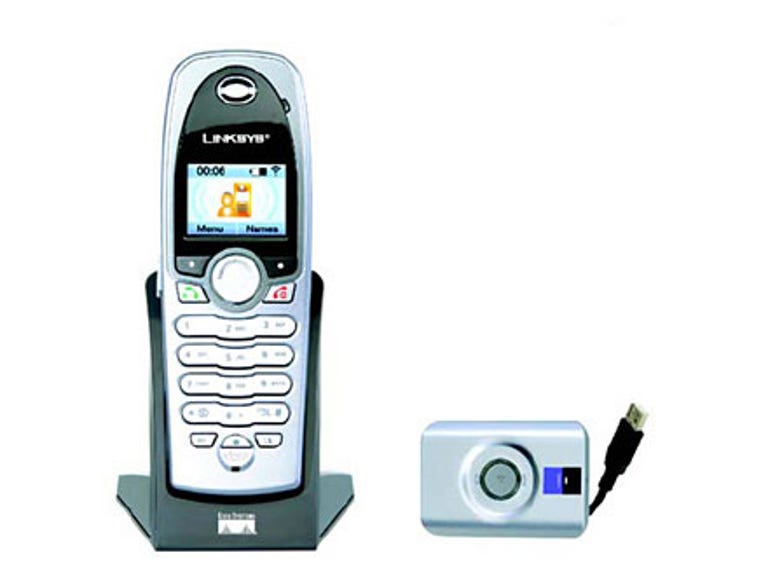 Why You Can Trust CNET
Why You Can Trust CNET Linksys CIT200 Skype Phone review: Linksys CIT200 Skype Phone
Linksys' CIT200 Skype Phone does a good job of bringing the Skype experience to the cordless handset world. It's not without its flaws, however, and you'd be well advised to carefully research your VoIP options before making a purchasing decision.
Design
Linksys' CIT200 Skype Phone looks, for all intents and purposes,
just like another cordless DECT phone. We placed our review unit
in a standard Sydney suburban home right next to a standard
Uniden DECT phone, and on more than one occasion picked up
the wrong handset. The base phone unit has a standard array of
call buttons, a small colour screen and the all-important Skype
button at the base of the phone. That sits on a very standard
charger and awaits a signal from the USB base station that
connects up to your PC and the provided Skype client.
Installation is thus very simple; run the provided install CD to
provide drivers and the core
Skype software (if you're not already running it), and then
synchronise the phone to your Skype installation.
The Good
The Bad
The Bottom Line
Skype, if you're not familiar with it, works in much the same way as any other VoIP based service, although it's notable in that it's primarily designed as a PC to PC calling software; as such the phone itself won't do anything if your PC isn't currently powered up and running the Skype client. It's also totally incompatible with other VoIP services, as Skype uses a different communications protocol for its voice calling.
Features
As a standalone phone, the CIT200 performs much as any other
cordless phone, albeit one with a Skype-centric service model.
You can alter calling tones, copy over your Skype contacts for
seamless free calling, and that's about it. Once the software's
installed on your PC, it will by default launch every time
Windows starts, start up the Skype client itself and then seek
out the CIT200 phone from the base station. The base station also
features a large paging button for those times that the phone's
been lost behind the sofa or in the outside shed.
The CIT200 package also proudly proclaims on its packaging that it comes with 60 minutes of SkypeOut service. SkypeOut is Skype's calling service to regular phones, with associated charges. The 60 minute claim is a touch deceptive; you don't in fact get an allocation of minutes, but an allocation of funds -- when we redeemed the code within our trial pack, we got €1.02 worth of credit allocated to our account. Depending on where you were calling, that might make up sixty minutes of calling time -- but it might not.
Performance
There are a few interesting catches with the CIT200. Firstly, the
manual notes that you may find it broadcasting any and all of
your PC audio through the phone -- this is because in order to
act as both a speaker and microphone, the handset has to take
over some of these functions from your PC. We didn't hit that
particular problem, although we did notice that making calls
while playing music files often created audio playback problems
-- your experiences may vary.
The SkypeOut service isn't a bad one, and the inclusion of free dialling time is a useful hook, although it's a significantly less user-friendly experience than practically any other Australian VoIP service. This is because there's no local point of presence for the Skype service, and this means that all of your calls have to be routed internationally. The practical upshot here is that you have to insert full international dialling codes for all of your "real world" calls, every time. Compared to local VOIP services, which are essentially plug and play, this becomes grating very quickly. Still, the plan for the CIT200 is to sell it to confirmed Skype junkies, and for that market it's no trouble at all.
We've seen a run of VoIP-centric products here at CNET.com.au, from the CIT200 to all-in modem/router units such as Netcomm's NB9W recently. There's no shortage of hype surrounding VoIP, and seemingly no shortage of products either here or in the pipeline. This should give consumers both a great range of choices and lots of price competition, but it should also make you ponder your VoIP choices carefully. On the plus side, the CIT200 integrates superbly with Skype, and if you're already addicted to the service it's a great way to make it extremely portable. On the minus side, it's totally incompatible with any other bit of VoIP kit out there, and for real world phone calling it's considerably more expensive to run (you can find a table of the current rates here), and it's much more convoluted due to the need for international dialling codes.


